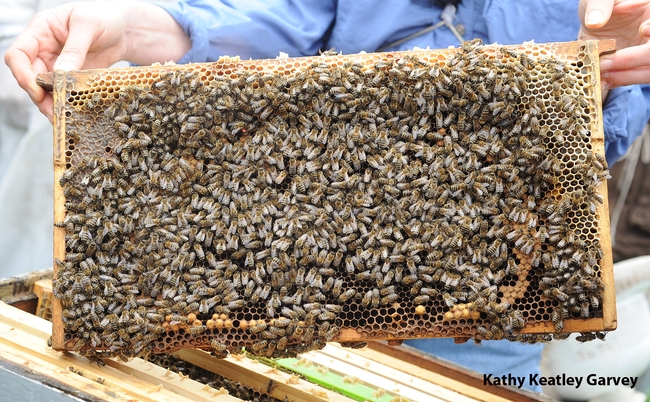
"How do I become a beekeeper?" he asked.
A very good question, and one that the UC Davis Department of Entomology answers a lot. Extension apiculturist Eric Mussen who's been with the department since 1976, is keen on helping.
"My advice to anyone who wishes to start keeping honey bees," Mussen says, "is to try to do the following, in order, if possible."
- Find and read some books on how-to-do-it beekeeping. They can be the less expensive paperbacks, like “Beekeeping for Dummies.”
- Try to find a beginning beekeeping course being taught this spring in your area. Many of the local clubs conduct such classes. (See this page)
- Try to become a member of a local beekeeping club. The members can help you get started and tell you what to watch out for in the neighborhood. If you cannot find a nearby club, see if you can find a nearby beekeeper to give you some tips. Some beekeepers list their services in the phone book Yellow Pages, under beekeeper or beekeeping.
But what about that reconditioned bee hive?
"It would be best to determine why the previous owner is no longer keeping bees," Mussen says. "If the colony died off due to American foulbrood (AFB) disease, the infectious spores will still be in the equipment. Putting new bees on the combs will simply result in loss of the new colony to disease. This is why I suggest that you become acquainted with an experienced beekeeper. He or she will be able to examine your used equipment to determine if it contains 'scales' of an old AFB infection. You can look up this information on the web or in textbooks, but until you have seen the scales, personally, it is hard to detect them."
How do you obtain bees for your hive? There are several ways.
"You can obtain bees by collecting swarms, extracting colonies from current hives, or by doing what most beginning beekeepers do, purchasing 'packages.' A package is a wire screen box containing either two or three pounds of bulk bees and a mated queen confined in her own separate cage. You take four frames out of your bee box, remove the lath holding the food can in the package, take out the queen cage and put it in your shirt pocket, dump and shake the bulk bees into the hive, spread the clump of bees out with your hive tool, and replace the four frames."
"Take the queen cage out of your pocket and, using a toothpick or wooden match stick, push a small hole through the queen candy at one end of the queen cage (you may need to remove a cork from the candy end, but I doubt it – DON’T IMPALE THE QUEEN!). Then, position the queen cage between two combs such that the screen is available to the bees at all times. Squeeze the two combs together to hold the queen cage in that appropriate position and close up the hive. Within three days, the bees should have chewed out the candy and liberated the queen. She will begin laying in another day or two. You can check for eggs a week after you installed the package."
"If all of this sound like gibberish and lingo to you, it is time to start a heavy dose of reading on bees and beekeeping," Mussen suggests.
Excellent advice! It's especially important when you're poking around with a matchstick not to "impale the queen!"
For more information on beekeeping, read his Bee Briefs on his website (he has one brief titled "Beginning Beekeeping") and his newsletter, from the UC Apiaries.
Attached Images:

Bee breeder-geneticist Susan Cobey of UC Davis and Washington State University shows how to hold a queen--by the thorax. (Photo by Kathy Keatley Garvey)

A frame of Susan Cobey's New World Carniolan bees (Photo by Kathy Keatley Garvey)